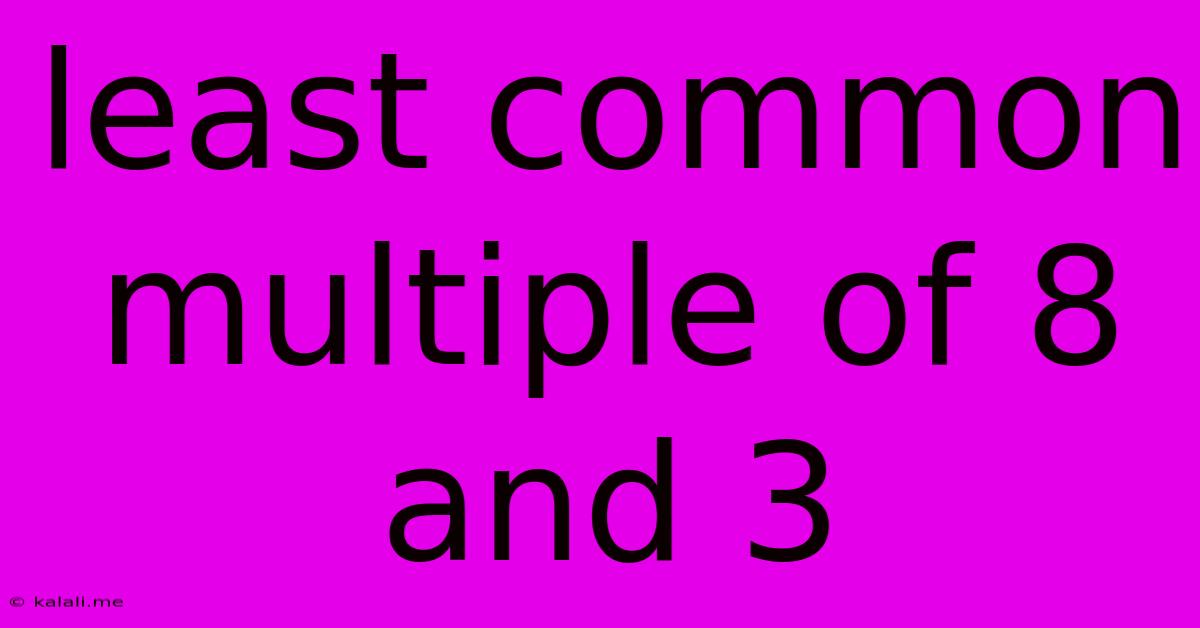Least Common Multiple Of 8 And 3
Kalali
May 09, 2025 · 3 min read

Table of Contents
Finding the Least Common Multiple (LCM) of 8 and 3
Finding the least common multiple (LCM) is a fundamental concept in mathematics, particularly useful in simplifying fractions and solving problems involving ratios and proportions. This article will guide you through the process of determining the LCM of 8 and 3, explaining the different methods and providing a clear understanding of the underlying principles. Understanding LCM is crucial for various mathematical operations and applications.
What is the Least Common Multiple (LCM)?
The least common multiple (LCM) of two or more integers is the smallest positive integer that is divisible by all the integers without leaving a remainder. In simpler terms, it's the smallest number that both numbers can divide into evenly. This concept is frequently used in arithmetic, algebra, and even more advanced mathematical fields.
Methods for Finding the LCM of 8 and 3
There are several ways to calculate the LCM of 8 and 3. Let's explore the two most common methods:
1. Listing Multiples Method:
This method involves listing the multiples of each number until you find the smallest multiple common to both.
- Multiples of 8: 8, 16, 24, 32, 40, 48, ...
- Multiples of 3: 3, 6, 9, 12, 15, 18, 21, 24, ...
Notice that 24 is the smallest number that appears in both lists. Therefore, the LCM of 8 and 3 is 24. This method is straightforward, especially for smaller numbers, but can become cumbersome with larger numbers.
2. Prime Factorization Method:
This method uses the prime factorization of each number to find the LCM. Prime factorization involves expressing a number as a product of its prime factors.
- Prime factorization of 8: 2 x 2 x 2 = 2³
- Prime factorization of 3: 3
To find the LCM using prime factorization, take the highest power of each prime factor present in the factorizations of both numbers and multiply them together. In this case:
- The highest power of 2 is 2³ = 8
- The highest power of 3 is 3¹ = 3
Therefore, the LCM of 8 and 3 is 8 x 3 = 24. This method is generally more efficient for larger numbers.
Applications of LCM
Understanding and calculating the LCM has practical applications in various areas, including:
- Fraction addition and subtraction: Finding a common denominator is essential for adding or subtracting fractions. The LCM of the denominators provides the least common denominator (LCD).
- Scheduling problems: Determining when events will occur simultaneously. For example, if two events repeat every 8 days and 3 days respectively, the LCM will tell you when they will occur on the same day.
- Ratio and proportion problems: Solving problems involving ratios and proportions often requires finding the LCM to simplify calculations.
Conclusion
Determining the least common multiple (LCM) is a vital skill in mathematics. Whether you use the listing multiples method or the prime factorization method, understanding the concept of LCM and its calculation is crucial for solving various mathematical problems and applications. The LCM of 8 and 3, as demonstrated above, is definitively 24. Remember to choose the method most efficient for the numbers you are working with.
Latest Posts
Latest Posts
-
What Is 225 Degrees Celsius In Fahrenheit
May 09, 2025
-
How Many Ounces Are In 2 3 Cup Of Water
May 09, 2025
-
What Percent Of 36 Is 96
May 09, 2025
-
Least Common Multiple Of 3 8
May 09, 2025
-
How Many Meters Is 20 Cm
May 09, 2025
Related Post
Thank you for visiting our website which covers about Least Common Multiple Of 8 And 3 . We hope the information provided has been useful to you. Feel free to contact us if you have any questions or need further assistance. See you next time and don't miss to bookmark.